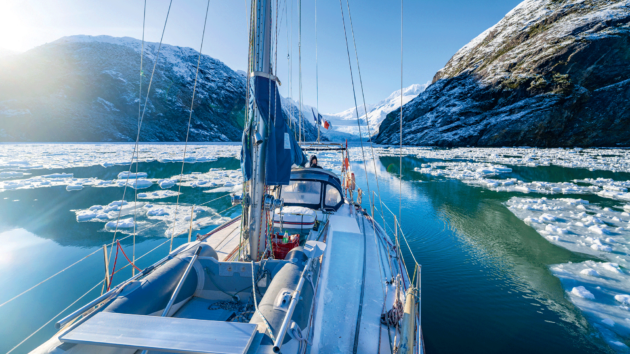Lauric Thiault captures a slow voyage through the most remote corners of the world, while sailing Patagonia
Patagonia isn’t a place you rush through. At least not if you want to experience it fully. Its fjords and channels, carved by glaciers and swept by wind, demand patience and reward curiosity. On a 35ft glassfibre sailboat, you don’t rush – not through williwaws, not through ice, and certainly not through the wilderness and remoteness you rarely find anywhere else.
Curiously, I never dreamed of being a sailor. My ideas of adventure were more about where I wanted to go than how I’d get there. I was drawn to the idea of wild landscapes and vast spaces, far from everything. Sailing came later – almost by accident – when my partner Nao and I realised it might be the perfect way to reach those places.
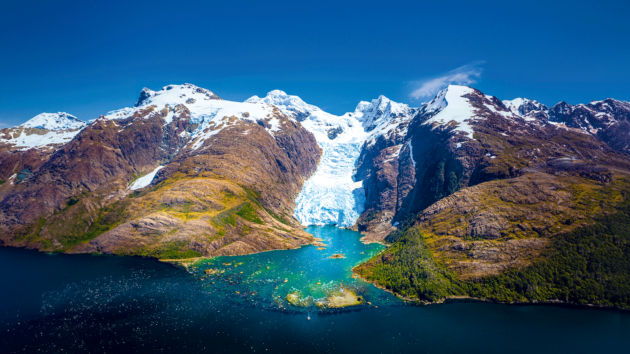
Lauric Thiault captures a slow voyage through the most remote corners of Patagonia. Photo: Lauric Thiaul
We first bought Tupaia, a 1970s Dufour 35, to see if the life afloat might suit us. In the beginning it was a lot of trial and error, spending our summers in the less-travelled corners of northern Europe. During the winters, we learned to fix whatever broke and fine-tuned Tupaia based on the experience gained over each season. Bit by bit, we learned our boat and found our rhythm.
The freedom and enjoyment of being self-reliant and taking care of our little floating home had us hooked. After three years of slow learning and growing confidence, we started to think bigger. Not record-setting voyages or dramatic crossings. Just longer trips in wilder places.
We’ve now spent 500 days sailing through southern Chile, mostly against the prevailing winds. Out here, freedom didn’t mean going wherever we wanted, whenever we pleased – it meant adapting to the weather, letting Mother Nature set the pace. Nothing happened quickly, and that was exactly how we wanted it.
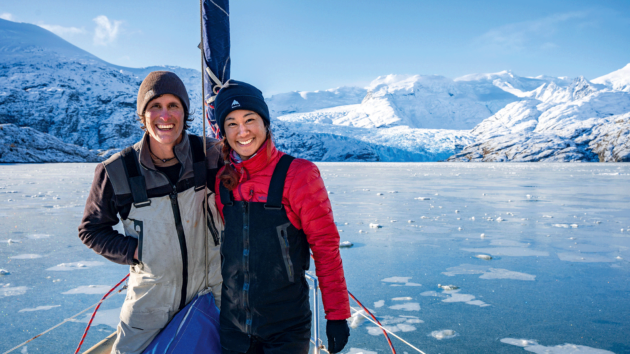
Lauric Thiault is a French environmental scientist and photographer who grew up in Polynesia. He and his partner, Nao Nakamura, have been living aboard their 1974 Dufour 35, Tupaia, for the past five years. In 2023, they set sail from Brittany for Patagonia, capturing their adventures at youtube.com/@tupaia. Photo: Lauric Thiaul
Sailing Patagonia: Tierra del Fuego in winter
Chilean Patagonia might be overrun if it weren’t so remote, and if its weather didn’t do such a good job of keeping most people away. The thousands of islands fringing the continent’s southern edge – from Cape Horn to Chiloé – stretch across 1,500 miles of countless fjords and weather-beaten islands. But despite its growing reputation among adventurers, the place still feels empty. Even in high season, most of this vast sailing ground sees few visitors.
We had just completed a focused 7,500-mile Atlantic crossing in four months to reach southern Chile before winter. It hadn’t been exactly rushed, but we’d made few stops, with little room for exploration. Arriving in Puerto Williams, the southernmost town in the world, we were ready to slow down.
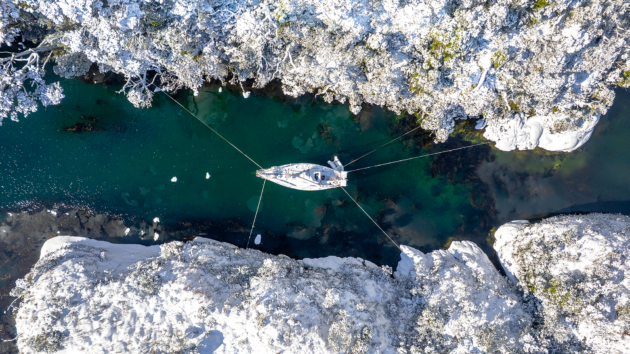
Mooring Patagonia-style at Seno Helado in the Canal Barbara. Photo: Lauric Thiaul
We began exploring the Beagle Channel which, despite lying at the ‘end of the world’, is surprisingly busy in the summer. Proximity to Ushuaia means charter boats and cruise ships weave through these waters en route to Antarctica. Come April, the crowds leave, and the golden days take over. As the South Pacific and Antarctic high-pressure systems drift apart, the ‘channel’ that funnels storms across Tierra del Fuego widens.
A stable high over the mainland often nudges those systems north or south, sparing the Beagle and giving us an unexpected number of calm and sunny spells. With the days shortening, the sun just hovered, low and golden behind the jagged peaks of the Darwin Range. Sometimes it felt like the entire day was a soft, extended sunrise, fading into a pink-toned evening.
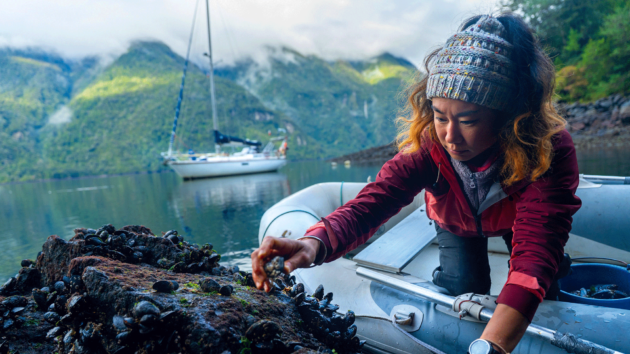
Last fjord, last catch – mussels at Estero Cahuelmo. Photo: Lauric Thiaul
Our life settled into a rhythm that would define our time here. The good weather brought busy days – we sailed, hiked, and fished. When the weather turned, we slowed down, reading, resting, and catching up on boat chores. Mornings began with lighting the stove and waiting for the warmth to slowly fill the cabin, something that could take hours in winter.
Evenings were dedicated to downloading GRIB files and sending our position to the Armada via Iridium, a system we deliberately chose over the cheaper and more efficient Starlink to avoid the distractions of the internet. No two days felt the same. As the seasons changed we felt the first ice floes tapping against the hull, saw the first glacier at arm’s length, there was the first time we hiked from the shore to the snow line above.
Article continues below…
How to sail around the world: Launching an epic adventure
Personal preparations and sailing skills are still the biggest part of planning to sail around the world. Knowledge and competence…
Confinement
Everywhere we went, we found an excess of perfectly sheltered coves known locally as caletas. Safe spots can be tight, but we quickly became proficient in the art of mooring Patagonian-style: backing into tight inlets, dropping the anchor and running long stern lines to trees or boulders on shore. It’s a method used routinely by local fishermen and sailors. Like many cruisers, we were hesitant at first. It seemed like a lot of hassle. But once in the channels, it quickly proved essential.
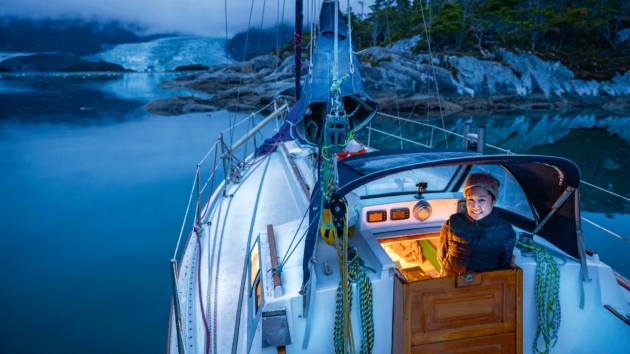
Blue hour with a view in Seno Pia. Photo: Lauric Thiaul
The holding ground here is generally excellent, but space is the real constraint. Gusts funnel down steep walls, so the most sheltered moorings are those where the seabed shelves sharply just a few metres from shore, ideally close to a dense patch of trees. When there is no shore as such, no transition between water and forest, you know that conditions in that spot are usually calm, even on the worst days.
We usually leave about three times the depth of chain on the bottom, then once the anchor is set, Nao rows ashore to set the first line while I keep the boat steady. That’s the tricky part: especially when the wind is pushing you out. But once the first line is set, the rest is easy.
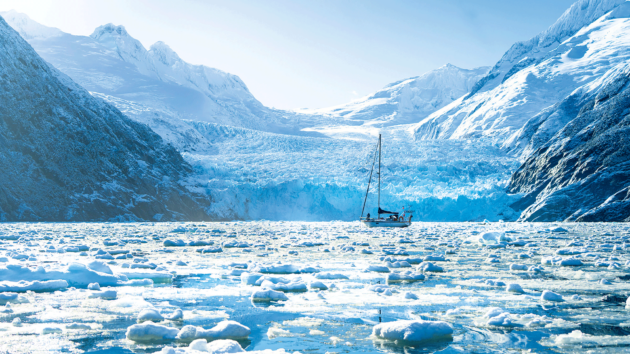
Navigating deep into a maze of growlers in Seno Garibaldi, Tierra del Fuego. Photo: Lauric Thiaul
We always put out a minimum of two lines to the stern, and if needed, we can easily add more at the bow. Tied in tight, Tupaia barely moves. And in a place where the wind can rise quickly, that stability turns a restless night into a peaceful one.
This proved especially true during our time in the Wollaston-Hermite Archipelago. We spent eight days holed up in Puerto Maxwell, pinned by back-to-back lows. Every morning, we checked the GRIB files, hoping for a reprieve, only to watch another massive front build in from the west. Gusts whipped through the anchorage in a steady run of williwaws, sending white spray across the surface and making our boat sway against her seven shorelines. Our rigging howled, the ‘furious fifties’ earned their name.
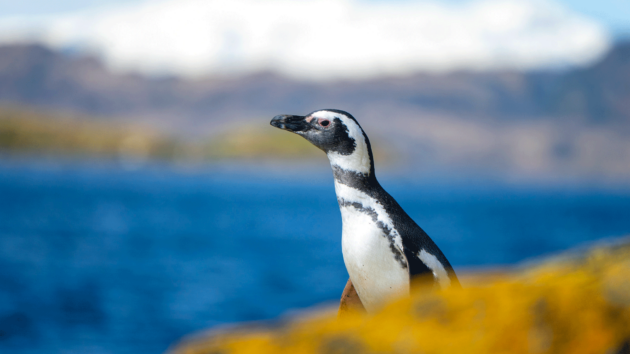
Magellanic penguin at Isla Rupert in the Strait of Magellan. Photo: Lauric Thiaul
But we didn’t mind. I would even go as far as to say that this was the most memorable – if not the highlight – of this section. There was something strangely exciting in being completely cut off, knowing that we could not return to the world nor the world come to us. Confined in the few square metres of the galley, we spent our days cooking, making small repairs, and watching the clouds stream down the mountains at unbelievable speed from our fogged-up window.
On a few occasions we managed to make short land excursions to watch the storm roll over Cape Horn and the surrounding islands – raw, powerful, and unforgettable from our vantage point.
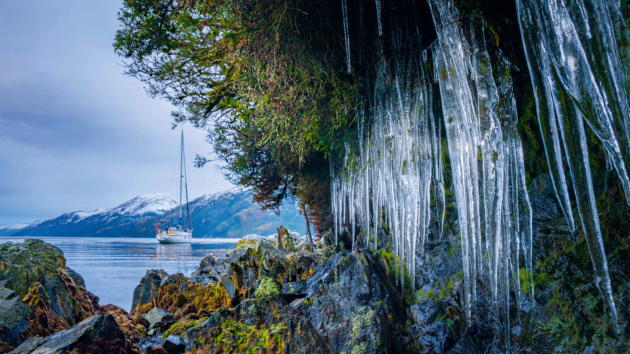
Frozen stalactites hang like a curtain along the shores of Caleta Chorito, Beagle Channel. Photo: Lauric Thiaul
Wildlife is woven into every corner of Patagonia. Caranchos, chimangos, kingfishers and other birds fill every anchorage – condors soar on thermals, V-formations of cormorants skim low over the fjords, and albatross glide effortlessly above the waves. Below the surface, dolphins, sea lions, and whales pass through, though it was on our return to the Beagle Channel, off Ushuaia, that we encountered the most striking concentrations of marine life.
We used our time in Ushuaia to provision, stuffing fresh produce and four months’ worth of dry and canned food in the hold. It was also a last chance to glean advice from the few charter professionals still around. We left Ushuaia and Puerto Williams under clear skies, making the best of an easterly breeze through the Beagle Channel before veering north around the eastern tip of Tierra del Fuego.
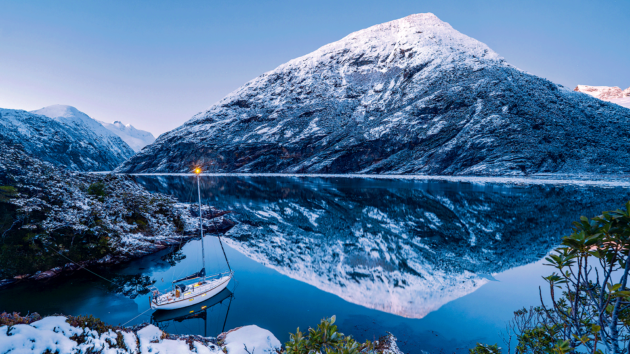
Still waters of Seno Garibaldi capture the mountain’s reflection, under a serene sky, at Caleta Scherzo. Photo: Lauric Thiaul
There, we faced the toughest passage of the trip. Our resolve to see Patagonia as more than a series of challenges was swiftly shaken. It was here we faced the toughest passage of the trip. Conditions were cold and relentless, with williwaws flinging water into the air like smoke so dense it obscured the shoreline, turning the landscape into a blur of blue-grey and noise. On the towering cliffs of dark, bare rock surrounding us, waterfalls that hadn’t frozen were blown back upwards by the wind.
When we finally reached shelter in Caleta Brecknock, we discovered the full extent of the damage: one of the shrouds was compromised, and both the staysail and mainsail were torn. It took us a week to carry out repairs.
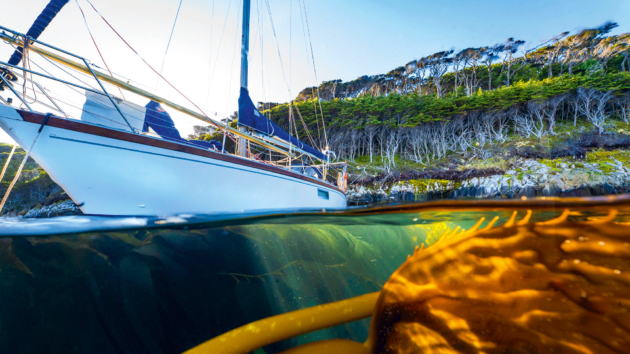
Kelp forests can tangle in the propeller. Photo: Lauric Thiaul
From then on Tupaia began making new noises; small creaks and groans that hinted at stress in the structural bulkheads. Yet rather than discourage us, the experience only deepened our commitment. There was something profoundly satisfying about moving through Patagonia’s remotest corners entirely on our own and taking full responsibility for every part of the journey.
Legendary waters
Sailing through these waters, it’s impossible not to think of those who came before us – Magellan, FitzRoy, Martial, Sarmiento, Agostini – figures who shaped the history of these coasts, and whose names now mark channels, mountains, and anchorages. It blows my mind to think how they managed to navigate these waters under such harsh conditions, with no charts, no forecasts, and no room for error.
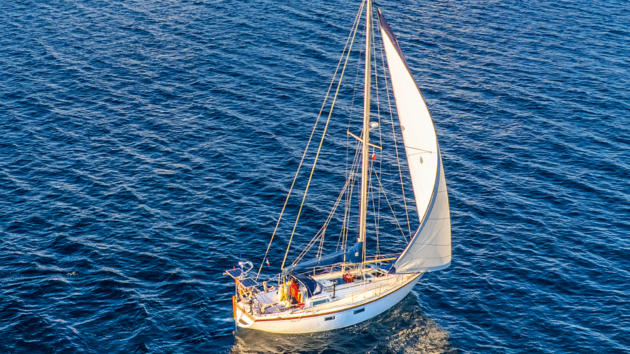
A calm winter day in the Wollaston-Hermite archipelago. Photo: Lauric Thiaul
And long before them, the Yámanas and Kawésqar had been navigating this coastline for thousands of years, in open canoes, guided by a deep knowledge of, and connection to, this place.
With each mile, the sailing grew more remote, the landscape more dramatic. There were no beacons, no lighthouses, nothing but the contours of the land to guide us – along with our own judgment and, of course, the chartplotter. By the time we reached Seno Agostini we were surrounded by so many tidewater glaciers spilling into the sea that we started calling it ‘Glacier Avenue’.
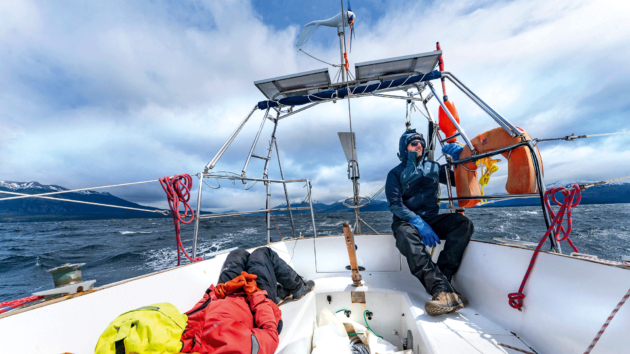
Making good speed across Golfo Almirante Montt. Photo: Lauric Thiaul
Dozens of ice tongues curled down from the peaks, some wide and stately, others fractured and blue, creaking under their own weight. The stillness was broken only by the distant crack of calving seracs and the faint scrape of the frozen layer of ice brushing against the hull.
We entered the legendary Strait of Magellan at Cape Froward – the southernmost point of continental South America. Westbound sailing in this section is famously difficult: the strait’s shape funnels the prevailing north-west winds directly against you, while contrary currents and a steep, short-period sea make every mile hard-earned.
On top of that, the season was shifting from winter to summer, bringing chubascos – sudden unpredictable squalls. But we took it slow, tacking from one side of the strait to the other, making small but steady progress each day.
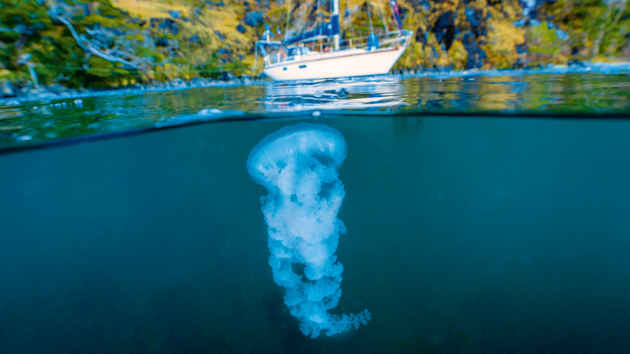
‘We became proficient in the art of mooring Patagonian-style’. Photo: Lauric Thiaul
Over the course of a month, we had just three calm days which we used to make detours – one to a spectacular tidewater glacier, another to a penguin colony tucked into the forest. The rest of the time, we worked our way forward into headwinds of 25-30 knots on the better days. On the harder days, the wind howled relentlessly, making progress impossible. We stayed put, riding out the weather in windy anchorages. It was here that Graham Cox spent a month waiting for favourable conditions before he could continue westward.
Outside, the weather was so ridiculously bad that we could only laugh.
At least we had the company of the local fishermen, whose kindness and generosity stood out. We always made a point of going over to chat. Despite the hard, exhausting nature of their work, they welcomed us aboard to drink mate and offer astonishing amounts of shellfish, fish, centolla (king crab), or sea urchins.
These encounters became some of the most meaningful moments of the journey – opportunities to hear about their lives, the history of the region, and to gain invaluable local knowledge about anchorages and places worth exploring. No-one knows these waters better.
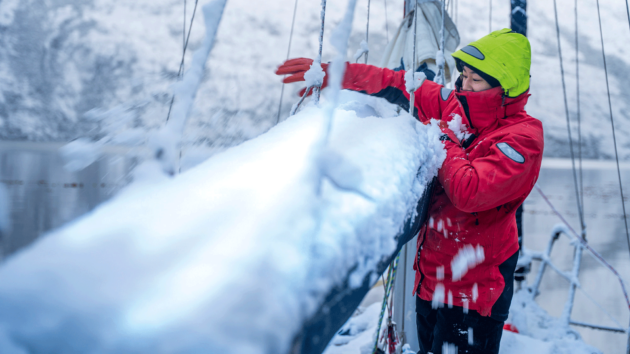
Winter sailing takes a little extra work, but the reward is having these wild places all to yourself. Photo: Lauric Thiaul
Our only chance to sail downwind came during detours to the east. That wasn’t the reason we chose to visit the Última Esperanza area, but it was a relief when conditions finally worked in our favour after two months of sailing to windward. This region lies at the meeting point of two very different worlds. On one side are the wet, mountainous channels; on the other, the open plains stretch endlessly across Argentina.
Sailing through Última Esperanza offered a taste of both: the dramatic cliffs and glacier-fed fjords of the Cordillera de las Montañas, with condors circling overhead, and, beyond the Bellavista region, glimpses of the rolling pampa dotted with guanacos.
Summer in the Ice Fields
After some restocking in Puerto Natales and a quick visa run to Argentina, we set off on Christmas Day, working our way west then north again. By then the typical days of prevailing summer weather in the channels were well established: north-west winds and overcast skies. And it rained, not hard but almost every day. Nothing was dry but the stove and the wall behind it.
Ashore, the vegetation dripped with moisture, and the carpet of moss was as full as a sponge can be. Our route was lined with more cypress trees, and the nothofagus forests grew taller and thicker. We made a few diversions deep into the Andes, where the steep mountains and the narrow fjords intensified the sense of scale. But the grandeur of this region is found not only in what you see, but in what you know is out there.
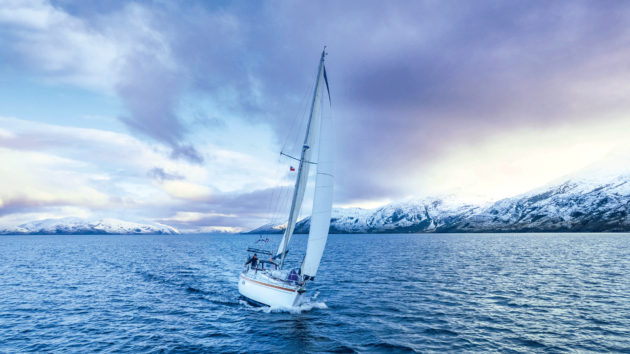
Sailing to windward on a calm winter day in the Brazo Noroeste of the Beagle Channel. Photo: Lauric Thiaul
That beyond the islands stretches a wilderness so vast and remote that few people, if any, have ever set foot on it. Given our modest sailing background, we hadn’t imagined reaching places so distant and so beautiful. When we came across our first huemules (south Andean deer), it felt like we were reaching a high point.
Then we entered Seno Eyre and reached Pío XI. Even in a region where the bar for scenery is already impossibly high, this glacier stands apart. It’s the largest tidewater glacier in South America, at 65km long, over 60m tall and 4.5km wide at the face.
We were already running short on superlatives, but Pío XI shattered whatever standards we had left. From our boat, we listened to sharp cracks and groans as the glacier inched forward. After a while, we could sense when a collapse was coming: the crackling would build, ice would shift, and then – with a thunderous roar – a massive block would break off and crash into the sea. We stayed the whole day, watching in awe, until the late summer dusk called us back to the safety of a caleta.
We’d now been in Patagonia for almost a year and were starting to feel more comfortable venturing off the main route. After a 10-day stop in Puerto Edén – the most isolated village in Chile – waiting for a weather window, we made a few more diversions into the uncharted, ice-filled fjords of the east. The sense of isolation was profound. Each anchorage felt as if no one had ever been there before.
Then came the Golfo de Penas, a milestone for anyone sailing through Patagonia. It marks the boundary between south and north; a point we’d been hearing about since Puerto Williams. Its reputation precedes it: conditions are so notoriously rough that most yachts make the circumnavigation as quickly as possible, eager to return to the shelter of the channels. Fortunately, a rare stretch of good weather allowed us to explore it more thoroughly than we’d ever hoped.
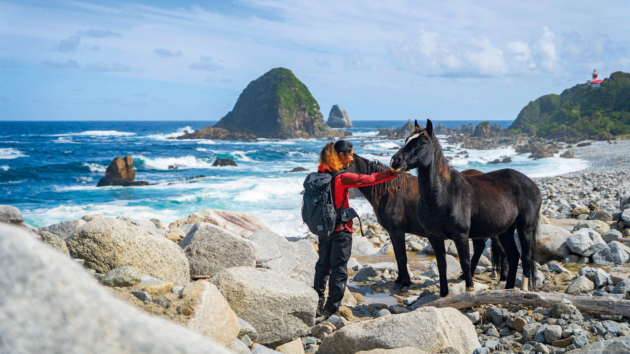
A friendly pause with horses along the path to Raper lighthouse. Photo: Lauric Thiaul
For 12 hours we were back in open water, with the Andes rising to starboard, the far horizon of the Pacific stretching out to port. We spent the night at sea, the calm almost surreal given the gulf’s reputation. The next morning the air was flooded with a deep yellow glow. In that vibrant light, albatross escorted us across the water.
What came next took us entirely by surprise. There’s little written about this section of the coast, and nothing had prepared us for what we found: wide, white sand beaches and lush green forests – it could have been north-eastern Australia were it not for the snow-covered peaks looming just behind. We had no idea a landscape like this even existed in Patagonia.
Further north lies the Taitao Peninsula, where the strongest weather system of the season shattered wind records: 97 knots, according to the keepers at the Raper lighthouse, who were still repairing their roof when we stopped by a few days later. But from the shelter of our cove, it all felt very far away.
A slow return
During one of our side trips we found ourselves in Laguna San Rafael, blessed with perfect weather again, approaching the last glacier of our journey. In the grandeur of the place, something closed: a chapter of the journey was behind us. Beyond this point the deep sense of isolation we’d experienced began to fade. Fish farms and the occasional small fishing village reminded us we were drawing closer to the edges of inhabited Patagonia. It was still wild, but no longer quite as remote.
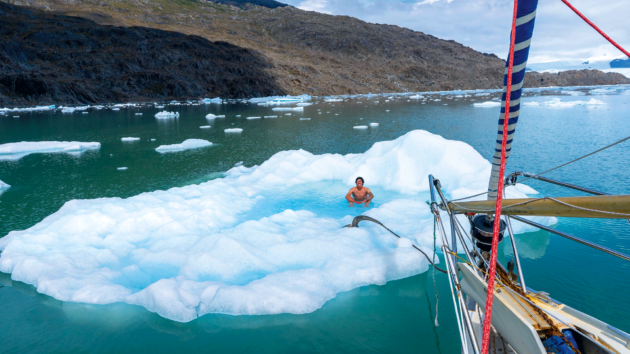
A refreshing dip in front of the Jorge Montt glacier. Photo: Lauric Thiaul
From there, we spent two months sailing back and forth between the Chonos Archipelago and the mainland, where volcanoes rose from the low clouds and thermal springs bubbled up from the earth. Finally we arrived in Chiloé, a bucolic escape from the harsh elements we’d been navigating for so long. The island’s charm lies in its gentle simplicity: rolling hills, picturesque villages, and a slow pace of life that eased the transition from the wilderness.
It’s no wonder people find the sailing life so hard to leave behind. How long it will hold us, I don’t know. But with more than 40 days of bluewater cruising ahead, bound for French Polynesia, one thing is clear: we’ve only scratched the surface of what this life can offer, of the raw beauty, exhilaration, solitude, and sense of freedom that comes with it. One day, we’ll return to these southern waters, not to retrace our steps, but to keep exploring freedom to its limits.
 If you enjoyed this….
If you enjoyed this….
Yachting World is the world’s leading magazine for bluewater cruisers and offshore sailors. Every month we have inspirational adventures and practical features to help you realise your sailing dreams.Build your knowledge with a subscription delivered to your door. See our latest offers and save at least 30% off the cover price.
Note: We may earn a commission when you buy through links on our site, at no extra cost to you. This doesn’t affect our editorial independence.




